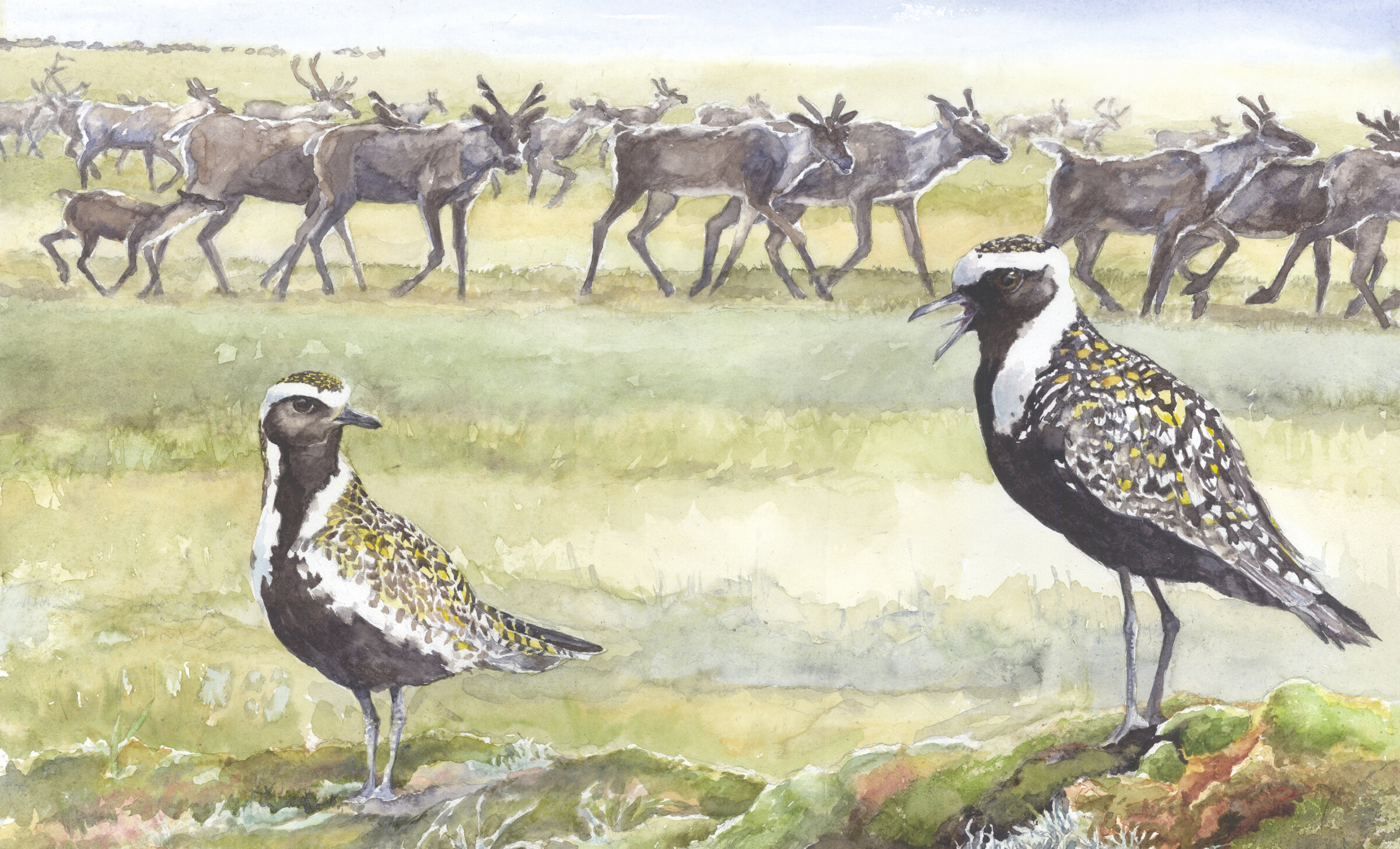ARCTIC BIRDS in the spotlight
"When I was selected to be the artist in residence for Arctic National Wildlife Refuge in 2019 I had imagined spending time on the tundra with iconic birds of the far north; Snowy Owls and Gyrfalcons, Ptarmigan and Tundra Swans. What I did not expect was the diversity of birds breeding on the coastal plain that were familiar friends. Semipalmated and Pectoral Sandpipers, Northern Pintail and Long-tailed Ducks, Red-throated Loons, Snow Buntings and Lapland Longspurs. These birds had all spent time in areas near my home; along coastal beaches or wetlands, farm fields or on the ocean. For 2 weeks I explored Arctic Refuge’s coastal plain helping with a study of the birds that use that unique landscape to raise their chicks. I discovered these ‘arctic breeders’ migrate through every state in the continental US (and many international locations) on their way to their wintering grounds, and serve to connect us all to the wilds of the arctic.”-Michael Boardman
Why Are ARCTIC BIRDS Important?
A recent study has shown that on a global scale, we have lost over 30% of bird populations over the past 50 years. If birds serve as bell-weathers for our environment, that is not a good sign for humanity’s effect on the natural world.
Arctic breeding birds live at the forefront of climate change, which is affecting the tundra ecosystem at a much faster rate than other ecosystems. In Arctic National Wildlife Refuge, America’s largest wildlife refuge at 19 million acres, they use one of the last complete bioregions that is spared of direct human influence. The refuge sits at the convergence of 4 North American flyways (migration paths) and the East Asian-Australasian flyway. Populations of these birds that use the arctic to reproduce give us connection and information, not only about the tundra but about all the important habitat they use along their migratory flyways.
what are the challenges facing ARCTIC BIRDS ?
Like so many species endangered by human impact, the major threat to birds is loss of suitable habitat. In the arctic climate change is slowly eating away at certain birds’ habitat requirements.
Slight increases in temperature melt the permafrost barrier under the soil, draining wetlands and changing insect and small mammal life cycles, which most of the birds rely on.
The overlying threat of oil development and infrastructure, especially in Arctic National Wildlife Refuge, is also a big issue for the survival of certain species. The wilderness quality of Arctic Refuge’s coastal plain (where drilling is proposed) and the lack of predators in this area would change dramatically with oil and gas development, not to mention the effect all that fossil fuel production would have on the climate. See this article from Audubon about how drilling might affect the birds of the refuge.
These migratory birds also face issues all along their flyways, from beach and seaside development to loss of grassland habitat, all essential feeding stopovers on their way to their wintering grounds.
what can WE do to help?
STUDY Arctic Birds
Watch for certain bird species that migrate through your area in the spring or fall. What are they doing? Where are they headed? Shorebirds are especially fascinating, many breed in the arctic and migrate all the way to Central and South America, stopping along the way to fuel up for a straight flight thousands of miles away. In winter look for snowy or short-eared owls, snow buntings, horned larks and lapland longspurs that spend the season foraging in tundra-like areas; including open fields, marshlands and airports.
Manomet conducts long term studies of shorebirds across their flyways. Project SNOWstorm conducts snowy owl research as does The Owl Research Institute.
Other links for info on arctic birds:
https://www.audubon.org/news/the-arctic-no-longer-safe-haven-breeding-shorebirds
https://blog.nationalgeographic.org/2013/04/24/arctic-breeding-birds-need-our-attention/
https://www.allaboutbirds.org/news/north-of-the-treeline-arctic-breeding-birds/
CELEBRATE Arctic Birds
Every year the US Fish & Wildlife service in Alaska holds a week of celebration for the birds that breed in Arctic Refuge.
Try to find which arctic birds travel through your area and when, and discover where they are headed. Go watch some birds, they can be quite entertaining and informative!
Create your own artworks about arctic birds and share them with the world. Use #CreatureConserve hashtags when posting them online.
Protect Arctic Birds
Advocate for solutions to the global climate crisis and encourage your representatives to permanently protect the coastal plain of Arctic National Wildlife Refuge from industrial development. For information on that fight see the Alaska Wilderness League.
Keep bird disturbances to a minimum, whether it’s flocks of shorebirds feeding at the beach tideline or snowy owls trying to find prey amongst photographers and sightseers.
Find out which habitats the arctic birds use in your area and make sure the birds are taken into account for any management plans.


